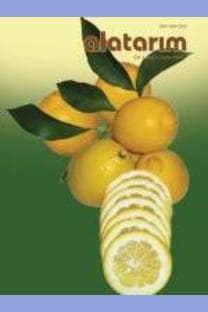Demir klorozu üzerine farklı demir uygulamalarının etkisi
kloroz, kireçli topraklar, demirli gübreler, kireç, bitki bozuklukları, anaçlar, asma
The effects of different iron Applications on Iron chlorosis of grapevines
chlorosis, calcareous soils, iron fertilizers, lime, plant disorders, rootstocks, grapevine,
___
- Akgül, H., Uçgun, K., 2004. Meyve Ağaçlarında Gübreleme. Türkiye 3. Ulusal Gübre Kongresi, Tarım-Sanayi-Çevre: 11-13 Ekim, Tokat, 1277-1312 s.
- Aktaş, M., 2004. Bitkilerde Beslenme Bozuklukları ve Tanınmaları. Türkiye 3. Ulusal Gübre Kongresi, Tarım-Sanayi-Çevre: 11-13 Ekim, Tokat, 1118-1186 s.
- Anonymous, 1997. Descriptors for Grapevine (Vitis ssp.). International Plant Genetic Resources Institute, Rome, 58p.
- Arnon, D., 1949. Copper Enzymes in Isolated Chloroplast: Polyphenoloxidase in beta vulgaris. Plant Physiol., 14:1-15.
- Bavaresco, L., 1990. Investigations on Some Physiological Parameters Involved in Chlorosis Occurrence in Different Grapevine Rootstocks and a Vitis vinifera Cultivar. Vitis Special Issue: 305-317.
- Bavaresco, L., 1997. Relationship Between Chlorosis Occurence and Mineral Composition of Grapevine Leaves and Berries. Commun. Soil Sci. Plant Anal., 28 (1-2): 13-21.
- Bavaresco, L., Bonini, P., Giachino, E., Bouquet, A., Boursiquot, J. M., 2001. Resistance and Susceptibility of Some Grapevine Varieties to Lime-induced Chlorosis. Acta-Hort.,(528): 535-541.
- Bavaresco, L., Fogher, C., 1992. Effect of Root Infection with Pseudomonas fluorescens and Glomus mosseae in Improving Fe-Efficiency of Grapevine Ungrafted Rootstocks. Vitis, 31(3): 163-168.
- Bavaresco, L., Fraschini, P., Perino, A., 1993. Effect of the Rootstock on the Occurrence of Lime-induced Chlorosis of Potted Vitis vinifera L. cv. Pinot Blanc. Plant and Soil,57(2): 305-311.
- Bavaresco, L., Fregoni, M., Fogher, C., 1995. Effect of some Biological Methods to Improve Fe-efficiency in Grafted Grapevine. J. Abadia (Ed.), Iron Nutrition in Soils and Plants, Kluwer Acad. Pub. 83-89 p.
- Bavaresco, L., Fregoni, M., Fraschini, P., 1992. Investigations on Some Physiological Parameters Involved in Chlorosis Occurrence in Grafted Grapevine. J. of Plant Nutr.15(10): 1791-1807.
- Bavaresco, L., Fregoni, M., Perino, A., 1994. Physiological Aspects of Lime-induced Chlorosis in Some Vitis Species. I Pot Trial on Calcareous Soil. Vitis, 33: 123-126.
- Bavaresco, L., Giachino, E., Colla, R., 1999. Iron Chlorosis Paradox in grapevine. J. of Plant Nutr. 22(10): 1589-1597.
- Boss, A., Höfner, W., Schaller, K., 1984. A Mathematical Approach for Evaluating Iron Chlorosis Inducing Factors. J. of Plant Nutr., 7(11): 1605-1622.
- Colugnati, G., Porro, D., Stefanini, M., 2002. Management of Nutrition for Quality Viticulture.Hort. Abstr., 72(3):2121.
- Çelik, S., 1998. Bağcılık (Ampeloloji) Cilt:1 Anadolo Matbaa Ambalaj San ve Tic. Ltd. Şti.Baskısı, Tekirdağ, 426s.
- Eyüpoğlu, F., Kurucu, N., Talaz, S., 1996. Türkiye Topraklarının Bitkiye Yarayışlı Bazı Mikro Eelement (Fe, Zn, Mn) Bakımından Genel Durumu. Toprak Gübre Arş. Ens. Genel Yayın No.217, Ankara, 67s.
- Fregoni, M., Bavaresco, L., 1997. Scientific Contributions on the Calcerous Iron Chlororsis of the Grapevine. Vignevini, 24(9):61-70.
- Gretzmacher, R., 1997. Influence of pH Value, Iron Concentration and Root Injury on Growth and Mineral Content of Vine Cuttings in Nutritive Broth. Mitt. Klosterneuburg 27:207-213.
- Güzel, N., Gülüt, K. Y., Büyük, G., 2002. Toprak Verimliliği ve Gübreler. Bitki Besin Elementleri Yönetimine Giriş. Çukurova Üniv. Ziraat Fak. Genel Yayın No:246, Ders Kitapları Yayın No:A-80, Adana, 654s.
- Kacar, B., 1997. Gübre Bilgisi. Ankara Üniv. Yayın No:1490, Ders Kitabı:449, Ankara, 441s.
- Ksouri, R., Gharsallı, M. And Lachaal, M., 2002. Quick Diagnosis of Iron Induced Chlorosis in Vines (Vitis vinifera L.). Hort. Abst., 72(6): 5239.
- Lichtenthaler, H.K., Welburn, A.R., 1983. Determinations of Total Caretenoids and Chlorophylls a, b and Extract in Different Solvents. Biochemical Society Transactions, 11:591.
- Marschner, H., 1995. Mineral Nutrition of Higher Plants. Academic Press Ltd. 24-28 Oval Road, London, 862p.
- Marschner, H., Römheld, V., 1995. Strategies of Plants for Acquisition of Iron. Plant and Soil 165:261-274.
- Mengel, K., Breininger, M. Th. And Bübl, W., 1984. Bicarbonate, the most Important Factor Inducing Iron Chlorosis in Vine Grapes on Calcareous Soil. Plant and Soil 81: 333-344.
- Mengel, K., Kirkby, E.A., 2001. Principles of Plant Nutrition. Kluwer Acad. Pub. Netherland,565-571p.
- Perret, P., Koblet, W., 1984. Soil Compaction Induced Iron Chlorosis in Grape Vineyards:Presumed Involvement of Exogenous Soil Ethylene. J. of Plant Nutr., 7(1-5): 533-539.
- Römheld, V., 2001. The Chlorosis Paradox: Fe Inactivation as a Secondary Event in Chlorotic Leaves of Grapevine. J. of Plant Nutr., 23(11/12): 1629-1643.
- Schinas, S., Rowell, D.L., 1977. Lime Induced Chlorosis. J. Soil Sci., 28: 351-368.
- ISSN: 1304-2653
- Yayın Aralığı: 2
- Başlangıç: 2015
- Yayıncı: Alata Bahçe Kültürleri Araştırma Enstitüsü
Çukurova koşullarında turp yetiştiriciliği için elverişli ekim zamanlarının araştırılması
Nebahat SARI, NEZİHE KÖKSAL, Halit YETİŞİR, Hülya ULUTAŞ
Dünyada son yıllarda yürütülen asma ıslahı çalışmalarının hedefleri ve kullanılan ıslah yöntemleri
Fitofag böceklerin konukçu bitki kabul davranışları
Anamur yöresindeki muz seralarının yapısal ve işlevsel özellikleri
Cengiz TÜRKAY, H. Hüseyin ÖZTÜRK, Hasan PINAR, M. Murat HOCAGİL
Aşılı fide kullanımının sera kavun yetiştiriciliğinde beslenme durumuna etkisi
Demir klorozu üzerine farklı demir uygulamalarının etkisi
GÜLTEKİN ÖZDEMİR, SEMİH TANGOLAR
Bazı sofralık üzüm çeşitlerinin fenolojik dönemleri ile salkım ve tane özelliklerinin saptanması
GÜLTEKİN ÖZDEMİR, SEMİH TANGOLAR, HATİCE BİLİR EKBİÇ
Fuyu ve Harbiye Trabzon hurması çeşitlerinde kalite kayıpları ve önleme yolları
Ahmet Erhan ÖZDEMİR, Elif ERTÜRK, CELİL TOPLU, Mustafa KAPLANKIRAN, ERCAN YILDIZ
